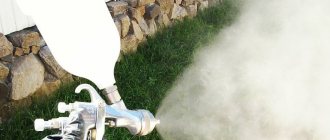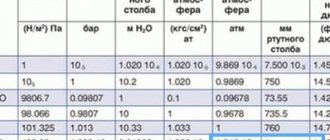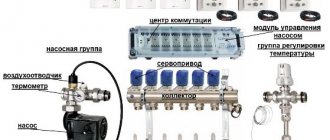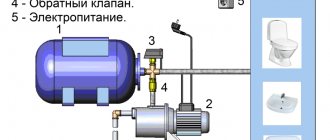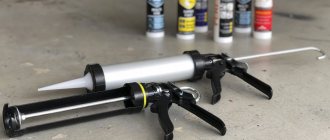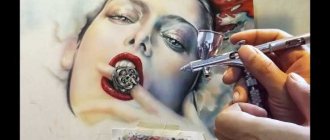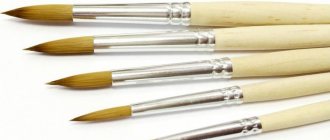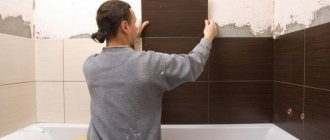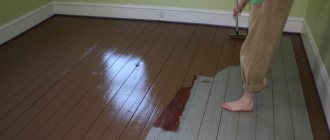Paint application can be carried out using manual tools, but the process will take a long time and the quality of painting will not always be high. To remove these moments, you can use a pneumatic spray gun. But it is important to choose the right spray gun in order to get good quality painting and use it for a long time. There are several types of devices; their features and rules of use will be discussed in detail below.
Operating principle and scope of application
To understand how best to work with a pneumatic sprayer, you should study the principle of operation of the device. Paints equipment using a motor that creates the necessary flow of compressed air. This air flows through the hose, the varnish or paint enters the wall through the gun. The composition must be collected in a special tank.
The pneumatic paint sprayer is designed so that the air moves to the gun, where there is a limiter on its output, the barrier is removed by pressing the trigger. Then the flow goes to the channels and nozzle for the spray gun, to the exit through the air cap.
The release of paint starts after pressing the trigger with great force. From such an impact, small particles are created from the paint and varnish material. Acrylic or other type of paint is evenly distributed over the surface under pressure.
Paints equipment using a motor that creates the necessary flow of compressed air.
Nozzle selection
Setting up the optimal operation of the spray gun is not based on regulators alone. An important part of this process is choosing the right nozzle capable of passing materials of a certain viscosity through it. The larger the diameter of the central hole of the nozzle, the thicker the mixture can be fed through it. If you want to figure out how to set up a spray gun for high-quality painting, it’s definitely worth paying attention to this detail.
You can determine what size nozzle is needed for spraying paint and varnish material from the information indicated on its container. Almost every more or less large manufacturer of paints and varnishes indicates the required nozzle diameter in millimeters with tenths (1.4, 1.5, 2.0, 3.0, etc.). Among the most common types of coating sprayed by a spray gun are:
- “Metallic” and other base enamels – 1.4 mm
- Primers -1.4 mm
- Clear varnishes – 1.5 mm
- Epoxy primers – 1.8 mm
- Liquid putties – 2.5 mm
The size of the nozzle opening affects the spray volume and the thickness of the resulting layer. If the hole diameter is smaller than required, the coating material will flow with difficulty and the painting speed will drop significantly. When the nozzle, on the contrary, exceeds the required dimensions, the paint is supplied in copious quantities, forming smudges or forcing the pace of work to be accelerated (in such situations, you can get out of the situation by tightening up the supply of material). The choice of nozzle may depend on the “style” of the master’s work. Some prefer to make a thin layer, while others like to specifically fill the part with the mixture. If you are just a beginner, it is best to use the medium nozzle sizes recommended by the paint manufacturer.
Pros and cons of pneumatic spray guns
A pneumatic spray gun for painting is distinguished by its ability to distribute paint over the ceiling using the air method, when the process involves applying a certain pressure. Painting work with this device can give good results, thanks to the following advantages of the spray gun:
- The layer obtained after painting has better appearance and quality when compared with the airless method;
- Durability of the device due to the use of metal parts that can cope with wear and tear longer. Loads exerted during work;
- Versatility, can be used for solutions of various viscous properties.
But, like any device, an air spray gun also has its disadvantages. Experts note the following points:
- It is necessary to select a suitable compressor to provide the required level of pressure;
- You should understand the operating rules of the device in order to regulate the operation correctly. You need to carefully read the instructions for the spray gun, then the spray gun will be adjusted correctly and the spray will be uniform; for this you need a gearbox with a pressure gauge;
- When working with the surface of a car, it is important to obtain a layer without defects that may appear from humidity in the air and other impurities. In areas of the car where defects are unacceptable, install a moisture separator and an air preparation device.
When painting areas of the house where a perfectly even layer is not necessary, using an electric spray gun is suitable; for demanding areas, a pneumatic paint sprayer is required.
The resulting layer after painting has better appearance and quality when compared with the airless technique.
Modern equipment for car painting
Modern industry has taken care to simplify the technological and technical aspects of the car painting procedure. Now this process is much more comfortable and less labor-intensive compared to coloring several decades ago. The invention of the spray gun made it possible for many car enthusiasts to transform their vehicles with their own hands so that the result is no worse than that of experienced craftsmen.
Depending on what exactly we need to paint - the entire car body or its individual part, the appropriate tool is selected. The most universal equipment for painting plastic and metal surfaces is considered to be a spray gun - a special paint sprayer that resembles a pistol in shape. With its help, you can paint both the entire car and its elements, while a brush is more suitable for working on small jobs and is not relevant for painting the car as a whole.
When working with a spray gun and knowing its specifics, it is important to know the limits within which the pressure varies for painting a car. It is this indicator that plays an important role directly in the dyeing process itself. The entire result will depend on how correctly it is adjusted. In order not to throw money and your own time down the drain, you should approach this with all seriousness and take into account the advice and experience of people specializing in this.
Incorrectly selected pressure for painting a car is fraught with certain defects in the paintwork. It would be logical to note the following:
- Pressure that is too high leads to drips and loss of paint. The result is a damaged job that needs to be redone.
- Excessively low pressure will not give the desired surface finish. In addition, you will need a powerful large compressor.
Main components of the mechanism
The set of parts that make up the spray gun is small. If you understand these components, then adjusting the spray gun will be easier. Below is an overview of the parts in the order in which they are installed to distribute the air before exiting the nozzle.
The set of parts that make up the spray gun is small.
Gun
The body part contains all the elements that ensure the spraying of the material. On the handle of the gun there is a place for a fitting where a hose is installed, from where the air comes. After the valve is attached to the trigger, in the barrel there is a closed valve for air flow and parts regulating the size of the torch, air pressure and paint supply. There is also a reservoir for the solution so that it does not just come out; a needle-tip serves as a barrier, which regulates the flow of paintwork.
The trigger, when pressed, opens the valves in stages, air starts first, followed by paint. At the exit, everything enters the nozzle, where the solution is broken into particles.
The body part contains all the elements that ensure the spraying of the material.
Tank
The tank into which the paint is poured is made in different ways. Its position can be on the side, which is convenient for small devices. The lower tank is convenient when processing vertical bases. Typically, such containers are made of metal and volumetric, about a liter. The top type of tank is versatile due to the ability to hold the spray gun in different positions.
Standard tanks are made of plastic.
There are vacuum types of containers. which can be installed in the desired position. Manufacturers call them disposable. but in practice, consumers use them several times.
The top type of tank is versatile due to the ability to hold the spray gun in different positions.
Nozzle (nozzle)
Due to the difficulty of cleaning, the nozzle is most often replaced. Typically, the part is sold together with an air cap and a needle, the reason is the need to select a set of these elements that is accurate in size.
Due to the difficulty of cleaning, the nozzle is most often replaced.
Additional items
A compressor spray gun will be easier to use if the kit includes additional parts. Their presence is optional, however, they will help to get the best result.
A compressor spray gun will be easier to use if the kit includes additional parts.
Gearbox for spray gun
A small device that consists of a pressure gauge and a pressure regulator. When working, it is important to know how much pressure is needed for the spray gun to create an even layer. Therefore, the presence of a regulator simplifies adjustment. There are mechanical and digital types of devices.
In the latest professional devices, the gearbox may be built-in.
The pressure gauge that is installed in the compressor can only show the pressure level when spraying. Requires setting the location of the part on the input part.
When working, it is important to know how much pressure is needed for the spray gun to create an even layer.
Water separator
When water-based or other paint must be applied without the slightest defects, it is necessary to exclude moisture in the air, it will leave craters on the surface. To do this, you need a moisture separator, which is placed between the handle and the end of the hose from the compressor.
There are small devices and special stations. The latter, of course, give the best result, completely eliminating moisture and pollution from the air. So it’s easier to get a metallic effect on a car by choosing a similar device.
When water-based or other paint must be applied without the slightest defects, it is necessary to exclude moisture in the air, it will leave craters on the surface.
Special occasion or acrylic paint
The fact is that acrylic dyes are created on the basis of two-component dyes. If in the case of the same oil or alkyd paint you can add a solvent in the required amount, then you should know how to dilute the paint correctly so as not to spoil the materials.
Read also: Caring for a spray foam gun
The first step when working with acrylic is to mix the dye with a special hardener. The proportions must be observed as specified by the manufacturer. A deficiency, as well as an excessive amount of hardener, will negatively affect the characteristics of the coating.
Next, I use a viscometer to check the viscosity and, if necessary, add a solvent. After obtaining a high-quality result in terms of viscosity, the diluted paint can be poured into the paint sprayer and work can begin. The coloring will be of high quality.
There are two ways to measure the required amount of base dye and hardener:
- using special measuring utensils;
- measuring ruler in a cylindrical container suitable for paint.
Measuring rulers are easy to use. The paint is poured into a cylindrical container, then a ruler is lowered there - when the paint level without adding a hardener reaches 40 cm, then to get a ratio of 1:4, it is enough to add a hardener up to 50 cm along the ruler.
Spray guns for acrylic and viscous paints
In industry, special sprayers are used for viscous coatings. The acrylic paint spray gun is an airless spray machine. So, the pump supplies dye under high pressure rather than air into the spray nozzle. But such equipment is expensive.
There is also a more affordable spray gun for acrylic paints - this is an ordinary tool where air is supplied not only to the nozzle, but also to the dye tank. The excess pressure forces the liquid through a special siphon tube.
Which is better
Instruments differ in different levels of consumption; low consumption is observed in devices of the LVLP type. In addition, the levels of pressure required to apply paint vary. Which option is required for a particular task is decided taking into account the solution that will be used.
The type of viscosity of the paint is important. Also, when purchasing, you should pay attention to the weight, size of the container for the material, strength of parts, the presence of additional attachments, and the ability to adjust the operating mode.
Instruments differ in different levels of consumption; low consumption is observed in devices of the LVLP type.
Tool parameter settings before use
Setting up a spray gun for beginners is one of the most difficult moments when using it for the first time. You should start by testing the parts for integrity. In this case, you need to fill the device three-quarters, and the engine turns on.
After connecting the hose to the gun, look at the quality of fastening the bolts and nuts. When you are convinced that the paintwork is not leaking and the work is proceeding uninterruptedly, you can proceed directly to painting the base.
You need to adjust the operating parameters of the tool using the regulator screw. The screw located at the bottom of the pistol part rotates. In one direction it increases the volume of air flow, in the other it decreases. The level of material supply is also regulated.
Turning the screw clockwise results in a circular spray pattern, while counterclockwise produces an ellipse.
You need to adjust the operating parameters of the tool using the regulator screw.
What is the function of air cap
The air cap is responsible for breaking the paint material into particles. The air flow is directed to the paint and a torch is formed. The moment of mixing air with the material occurs precisely with the help of an air cap. For this purpose, special holes are created in it.
The air cap is responsible for breaking the paint material into particles.
What should the torch size be?
Before setting up the spray gun, you need to understand what size torch is needed. The reference point is the area of the surface to be treated. When you need to create a narrow stripe of color, you need to make a small torch.
When the entire surface is to be painted with one color, choose the largest width.
Before setting up the spray gun, you need to understand what size torch is needed.
Advantages of sprayers
There are several positive qualities that spray guns designed for painting cars have:
- increased efficiency;
- environmental friendliness (by reducing the volume of the paint cloud);
- the treated surface always remains smooth, and the paint layer is distributed evenly, due to the absence of the production of various contaminants;
- The spray gun does not consume a small amount of air during the distribution process.
Using such paint sprayers will save financial costs and time. In addition, the spray gun does not pollute the environment, which is typical for ordinary aerosol sprayers in the form of cans.
Inlet Pressure Setting
The device, which is accompanied by official instructions, operates taking into account the permitted pressure norm. The best result is obtained when a regulator and pressure gauge are installed at the inlet. It is important to mount it closer to the handle, then the readings will be more accurate.
The device, which is accompanied by official instructions, operates taking into account the permitted pressure norm.
Setting the inlet pressure using a pressure gauge-regulator
The pressure gauge regulator helps to accurately adjust the pressure level, then the paint supply process will be correct. This parameter is important, otherwise the layer will be applied unevenly and paint consumption will increase. The best accuracy is obtained with a scheme where the part is placed at the input.
The pressure gauge regulator helps to accurately adjust the pressure level, then the paint supply process will be correct.
If the gun is equipped with a built-in pressure gauge
When this part is built into the spray gun, it acts as follows:
- The screw responsible for supplying air flow is unscrewed completely.
- The screw responsible for the shape and size of the torch is also unscrewed.
- Press the trigger, when the screws are unscrewed, air moves in.
- The pressure gauge sets the required pressure level.
The pressure gauge sets the required pressure level.
If the pressure gauge is without a regulator
There are devices where there is no adjustment screw installed, but there is a pressure gauge. Then the screw for the air flow is unscrewed completely, the torch screw also opens as much as possible. Press the trigger to force air into the gun. The pressure level is changed using a reducer located at the compressor outlet. The result is looked at on the pressure gauge.
The screw for the air flow is unscrewed completely, the torch screw is also opened as much as possible.
If there is no pressure gauge at all. Least accurate method
When a part is missing, how to set up a spray gun for painting. The adjustment is carried out using the compressor gearbox, taking into account the main pressure losses:
- The air supply compartment is unscrewed.
- The torch compartment opens.
- They pull the trigger.
- Not forgetting the loss of main pressure, use a reducer on the compressor and set the desired parameter. The level is set higher by 0.6 bar from the specified level when using a 10-meter hose with a diameter of 9 mm. To obtain better accuracy, it takes into account how many filters the device has.
The adjustment is carried out using the compressor gearbox, and the main pressure losses are taken into account.
Rules for using the spray gun
To avoid problems when painting, you should not forget about important working rules. Professionals note the following nuances:
- Internal work requires the creation of good ventilation;
- When working outdoors, use the tool without direct sunlight;
- Compositions for cars are explosive and therefore require careful attention from the technician;
- Dilution of the solution is carried out strictly according to the instructions.
When working outdoors, use the tool without direct sunlight.
A few words about solvents
To obtain the desired viscosity, solvents are used. The easiest way is to use the solvent recommended by the manufacturer. To avoid problems in case of incompatibility of solvents and paints, experts recommend buying both materials from the same brand.
There are general recommendations for what can be used to dilute various types of coloring materials:
- When painting with water-based paint, they can be diluted with distilled water, as well as alcohols and ethers. Ordinary water should not be used - during the drying process it causes the formation of a white coating on the surface.
- Oil-based paint compositions are diluted with drying oils, oil-resin varnishes or white spirit.
- Enamels should be diluted with gasoline, solvents No. 645 and 646, solvent, white spirit, xylene.
- Two-component coatings should first be mixed and then ensure that the viscosity is correct. For this you need a viscometer - with it you can accurately determine the viscosity of the paint being measured.
Setting up and using the spray gun
The scheme for using the tool is to configure the equipment. Make adjustments when the paint container is full and the lid is tightly closed. It works as follows:
- The air and paint flow is regulated, the device is placed vertically with the direction towards the paper.
- The trigger is pressed and held until drips appear.
- Afterwards, you can move the tool to understand what distance from the surface and speed are needed for uniform painting.
Next, you can paint the prepared surface.
Make adjustments when the paint container is full and the lid is tightly closed.
Test Spray
Glue a piece of masking paper to the wall. You can do test sprays on it.
Set the required pressure on the spray gun using the regulator. You need to set the pressure while pressing the trigger. First, close the air supply completely, pull the trigger until the air is blown out, but not the paint. Next, set the desired pressure so that it does not change when air is blown out. Then you can release the trigger and your gun will be adjusted to the required pressure and air volume.
Now turn the torch width control to maximum, and then turn it down a little. After changing the torch, the pressure at the inlet to the gun changes slightly, so you need to adjust it.
Now turn the paint regulator all the way. Next, open it 2 full turns (4 half turns).
You can start a test spray
Hold the gun level in front of the paper to test spray, at a distance of 15-20 cm. Now pull the trigger fully and immediately release. The test spray should look like a "cigar" shape with full paint on the inside and smooth edges on the sides (see illustration).
What problems can occur during test spraying and what is the cause?
The center must be completely painted without streaks. If smudges occur, then perhaps the spray gun is too close to the surface, or the paint is sprayed for a long time during the test. If the distance and time of the test spray are normal, then the spray gun is adjusted to deliver too much paint. You need to slow down the feed a little.
It is necessary that the spray gun sprays as small droplets as possible while maintaining good coverage.
Too much air pressure when painting will cause the droplets to form too small and the paint will fly all over the place. Excessive pressure causes excess consumption of sprayed material. The paint that reaches the surface forms a dry coating that looks matte and faded. High pressure during spraying can cause the formation of a number 8 pattern. This pattern leaves streaks when painting.
If the pressure is too low, the droplets become large, which causes large shagreen patches when painting (the “orange peel” effect).
How to set up a spray gun - basic nuances
When setting up, it is important to obtain the desired pressure level; the required parameter is indicated by the manufacturer on the packaging. The paint must also be brought to the desired level of viscosity. The integrity of all parts must be checked to prevent leaks.
When setting up, it is important to obtain the desired pressure level; the required parameter is indicated by the manufacturer on the packaging.
Preparation of paint and varnish material
To prepare the paint, you will need a marked plastic container or a measuring ruler. Manufacturing companies place information on the packaging about the proportions of mixing the mixture with the activating substance. For example, the 2x1 marking indicates the ratio of 2 parts of paint to one part of activator.
To more accurately control the proportions, you will need a measuring ruler. If this is not available, you can use a container with graduations printed on it.
One of the main indicators for high-quality spray painting is the viscosity of the composition. To obtain the paint of the desired thickness, a solvent is added to the activated mixture. It would seem that everything is simple, but not every manufacturer reports the required amount of solvent to add to the paint. Therefore, in such cases you will have to act by trial method. Experienced craftsmen prepare the mixture by eye - without using measuring utensils. For beginners, we can recommend purchasing only those formulations whose packaging contains detailed instructions on how to create the mixture.
Advice! If the package says, for example, 2x1+15%, then in addition to 2 parts of paint and 1 part of activator you will need 15% solvent.
If you plan to create a “metallic” effect or the surface needs to be given special protective properties, it is necessary to apply 2 layers of paint. First, a base coat is applied, and then an acrylate-based varnish is applied.
Acrylic varnish is prepared based on the recommendations of the manufacturer. Moreover, if the coating consists of 2 layers, there is no need to activate the paint, as the surface will dry due to the evaporation of the solvent.
Problems and their solutions
Any equipment can fail over time, due to wear and tear of parts and others. Some breakdowns can be fixed without any problems. Common problems will be discussed below.
Any equipment can fail over time, due to wear and tear of parts and others.
The gun doesn't paint
There are three options when you can use the spray gun for its intended purpose in case of this error:
- The air is supplied at low pressure; you just need to adjust the compressor;
- The nozzle or needle is dirty; until these parts are removed and cleaned, the paint flow will not open;
- The needle and nozzle are broken and should be replaced with new ones.
The nozzle or needle is dirty; until these parts are removed and cleaned, the paint flow will not open.
Spray gun spits
This type of failure can be caused by the problems described below:
- The air cap is loose and needs to be tightened;
- The pressure and viscosity of the material are not suitable, the indicators need to be brought back to normal;
- The paint is too thick and it will bleed;
- The breather on the container with the material is clogged and needs to be cleaned;
- The pressure has dropped, you need to bring it to the desired level.
The paint is too thick and it will bleed.
The torch moves to the side
It is possible that the hole on the side of the air cap is dirty and needs to be cleaned thoroughly. Or damage is detected on the holes, then new parts are installed.
It is possible that the hole on the side of the air cap is dirty and needs to be cleaned thoroughly.
A pneumatic spray gun can create a beautiful layer on a variety of surfaces. It is distinguished by the evenness of paint distribution, but it is important to set it up correctly before work. To do this, it is important to study the operating rules that were described above.
Viscosity of paintwork materials or why to dilute paint
Using expensive and high-quality paint, you can easily get unsatisfactory results. It is important to know exactly how to dilute spray paint. There are several main reasons:
- If the spray paint is too thick, it is very difficult to apply it evenly over the entire surface to be painted. The layer will take a long time to dry, and the thickness will affect material consumption and cost.
- If you apply the dye to vertical or inclined surfaces, the liquid paint will begin to flow and the drips will be very uneven. It will be very difficult to eliminate them.
- A thick dye will not be able to penetrate deeply into the pores on the surface, which will negatively affect the final result.
- Modern models of sprayers are not designed for high-viscosity materials. Therefore, they become clogged, which requires frequent disassembly to clean the internal channels and surfaces.
- To obtain a high-quality coating after using liquid paints and varnishes, several layers should be applied. This will affect the strength characteristics, as well as time costs.
